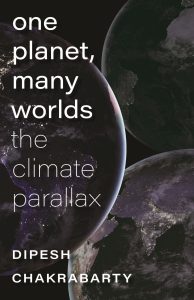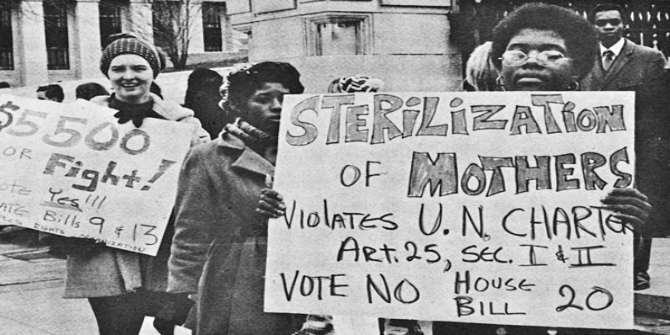 In One Planet, Many Worlds: The Climate Parallax, Dipesh Chakrabarty examines human interrelatedness with, and responsibility within, the Earth System from a decolonial perspective. Drawing on a diverse range of disciplines, this book is a critical intervention that considers perspectival gaps and differences around the climate crisis, writes Elisabeth Wennerström.
In One Planet, Many Worlds: The Climate Parallax, Dipesh Chakrabarty examines human interrelatedness with, and responsibility within, the Earth System from a decolonial perspective. Drawing on a diverse range of disciplines, this book is a critical intervention that considers perspectival gaps and differences around the climate crisis, writes Elisabeth Wennerström.
One Planet, Many Worlds: The Climate Parallax. Dipesh Chakrabarty. Brandeis University Press. 2023.
 In One Planet, Many Worlds, Dipesh Chakrabarty addresses existing perspectival gaps and differences around the Earth System. This latter term can be understood from the International Biosphere-Geosphere Programme’s definition (7) as a system integrated with the planet’s physical, chemical, and biological processes, of which humans are a part. Chakrabarty makes the “globe/planet distinction” (3) to navigate the climate crisis alongside the Earth System. The parallax is a helpful yet critical concept highlighting how appearances change depending on where the focal point rests.
In One Planet, Many Worlds, Dipesh Chakrabarty addresses existing perspectival gaps and differences around the Earth System. This latter term can be understood from the International Biosphere-Geosphere Programme’s definition (7) as a system integrated with the planet’s physical, chemical, and biological processes, of which humans are a part. Chakrabarty makes the “globe/planet distinction” (3) to navigate the climate crisis alongside the Earth System. The parallax is a helpful yet critical concept highlighting how appearances change depending on where the focal point rests.
Climate awareness is not a new concern, and the distribution of adverse climate impacts is highly unequal
The case in point: climate awareness is not a new concern, and the distribution of adverse climate impacts is highly unequal. Chakrabarty asserts that failures to act in relation to the Earth System are evidenced not only by the climate crisis but also in energy extraction politics (eg, 9 and19) and global justice debates (eg, 43 and 79). In contrast, he cites Kant’s emphasis on the “categorical imperative” to follow moral laws, regardless of their desires or extenuating circumstances. Arendt is further emphasised in the case for collective action. But in the Anthropocene, argues Chakrabarty (invoking Kant and Arendt on ethics), there are many signs of how the approach to addressing the climate crisis risks being “bereft of any sense of morality” (6).
Chakrabarty’s research interests intersect with themes in modern South Asian history and historiography, globalisation, climate change, and human history
As a leading scholar of postcolonial theory, comparative studies and the politics of modernity, Chakrabarty’s research interests intersect with themes in modern South Asian history and historiography, globalisation, climate change, and human history. This book demonstrates his extensive commitment to communicating change through a socio-historical narrative. The text is multidisciplinary in scope, moving freely between the natural and social sciences and the humanities. The critical premise is the need to learn from what may appear complex and from what is multifaceted.
He deconstructs “global warming” and “globalisation” by differentiating their relationship to the Earth System (eg, 19-21 and 56). Chakrabarty argues that the Earth System can be delimited as “a heuristic construct” when used in Earth System Science (ESS), wherein scholars’ focus on monitoring geological and biological factors (3). Chakrabarty finds a more fruitful discussion from a continued historicisation of “global histories” and the “geobiological history of the planet” in the different meanings of the “globe” – including “the 500-year-old entity brought into being by humans and their technologies of transport and communication…a human-told story with humans at its center” (3). The discussion includes the COVID-19 pandemic (Chapter One), postcolonial historiographies around an “Earth system” (Chapter Two), and the need to reconcile what Chakrabarty refers to “as ‘the One and the Many’ problem that makes climate change such a difficult issue to tackle” (15) (Chapter Three).
The climate crisis is entangled with political factors, economic growth processes and capitalism, in part seen in the reverberating effects of natural resource extraction
Chakrabarty contends that the climate crisis is entangled with political factors, economic growth processes and capitalism, in part seen in the reverberating effects of natural resource extraction – what many scholars refer to as the Great Acceleration. Complementary notes expand such negotiations to Derrida’s “democracy to come” (60) and Hartog’s discussion on the elements of time and space that pose a particular political problem in the Anthropocene (22, 69, 74). Here, perspectives differ not only over whether Anthropocenic humans lie at the centre, but around the Earth System, which is one while also entailing many differentiated and interrelated processes (7-8). He states: “Any human sense of planetary emergency will have to negotiate the histories of those conflicted and entangled multiplicities” (16).
Many injustices and inequalities in the Anthropocene are repressed, too; he gives the example of how many longed for the pandemic to be over and for life to return to normal, yet when it came to vaccinations, this desire turned political (22). The pandemic shows, according to Chakrabarty, how we are “entwined with the geological – over human scales of time and space” (73).
He references Foucault’s biopolitics where “natural history remains, ultimately, separate from human history” (31), and more of a critique on modern political thought: “We are a minority form of life that has behaved over the last hundred or so years as though the planet was created so that only humans would thrive” (39). In contrast, the biologist Margulis combined three Greek words (hólos for “whole,” bíos for “life,” and óntos for “being”), in the understanding of the holobiont, the superorganism that hosts a myriad of other life, of which humans are a part (38).
Chakrabarty offers no essential framework to address the climate crisis. Still, he contends that the critical question remains how to navigate the present and respond alongside the Earth System.
Chakrabarty offers no essential framework to address the climate crisis. Still, he contends that the critical question remains how to navigate the present and respond alongside the Earth System. He suggests that multiple entry points for the reconfiguration of hegemonic “contemporaneity,” can be found in the writings of thinkers across disciplines – from philosophers, physicists and botanists to activists, marine biologists and anthropologists, including Hartog (69), Latour (71), Todd (95), Winter (96), Haraway (98), and Kimmerer (103). By deconstructing “the globe” he reimagines the contours of connective global histories, citing the impetus of “Haraway and Indigenous philosophers—to make kin, intellectually and across historical difference” (102). Charabarty’s text draws together all these ideas to unpack the asymmetrical patterns of time and space in the Earth System and make a case for global environmental justice. Overall, Chakrabarty’s work One Planet. Many Worlds makes a critical intervention on how to think about the climate crisis, deconstructing the present way of being within the Anthropocene.
- This review first appeared at LSE Review of Books.
- Image credit: Triff on Shutterstock.
- Please read our comments policy before commenting.
- Note: This article gives the views of the reviewer, and not the position of USAPP – American Politics and Policy, nor of the London School of Economics.
- Shortened URL for this post: https://wp.me/p3I2YF-dNA






